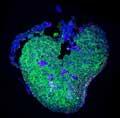Adult cell is the merit of regenerating the heart of zebra fish

Adult cells in the heart of zebrafish separate from adjacent cells, slightly alter their natural shape and begin to give new cells when they lose part of the heart from a wound or accident. Specifically, cells adjacent to the cut perform this training function.
The journal Nature has published two articles in which researchers from Duke University and others from the Barcelona Center for Regenerative Medicine and the Salk Institute of California report on research on the regenerative capacity of zebrafish hearts. Zebrafish, and other animals, are able to reproduce the lost body parts, and scientists wanted to know the mechanism by which they did.
Well, the two groups of researchers have come to the same conclusion, that is, they have seen that, in the case of zebra fish hearts, at least adult cells are responsible for regeneration and not stem cells. To do this, both groups took advantage of the fluorescent green protein to experiment.
One group introduced the gene to produce this protein in adult heart cells. By removing a part of the heart and completing it by itself, they observed that in the reformed part proteins produced a fluorescent protein, so they were produced from adult heart cells.
The other group transformed the fish, causing the fluorescent protein to occur only in the expression of a specific gene. This gene is only expressed in the embryonic phase. Well, they observed that in adult cells that assumed the function of completing the lost part this gene was activated, which began to produce green protein.
Photo: Juan Carlos Ispizúa Belmonte, Salk Institute
Buletina
Bidali zure helbide elektronikoa eta jaso asteroko buletina zure sarrera-ontzian











